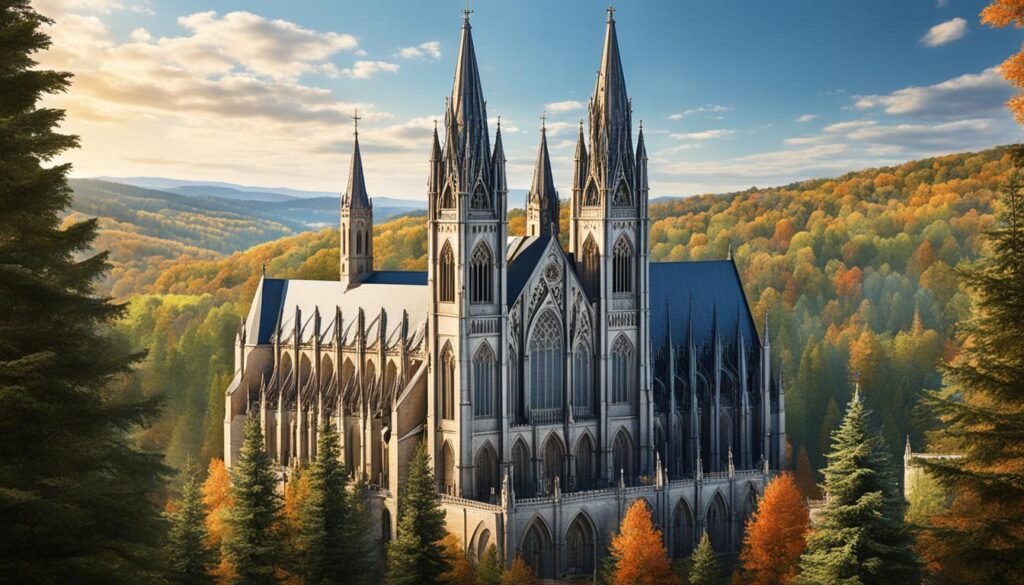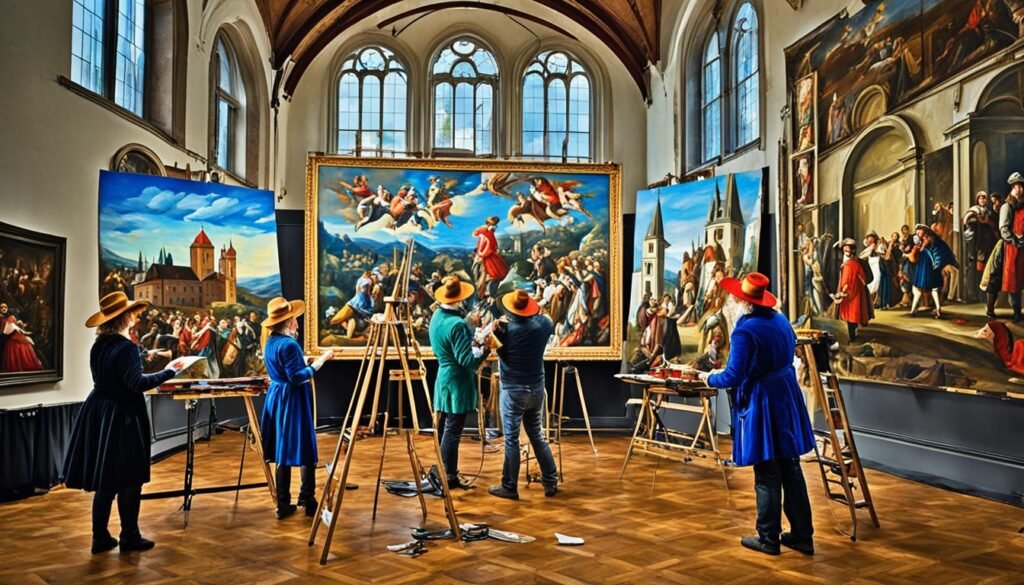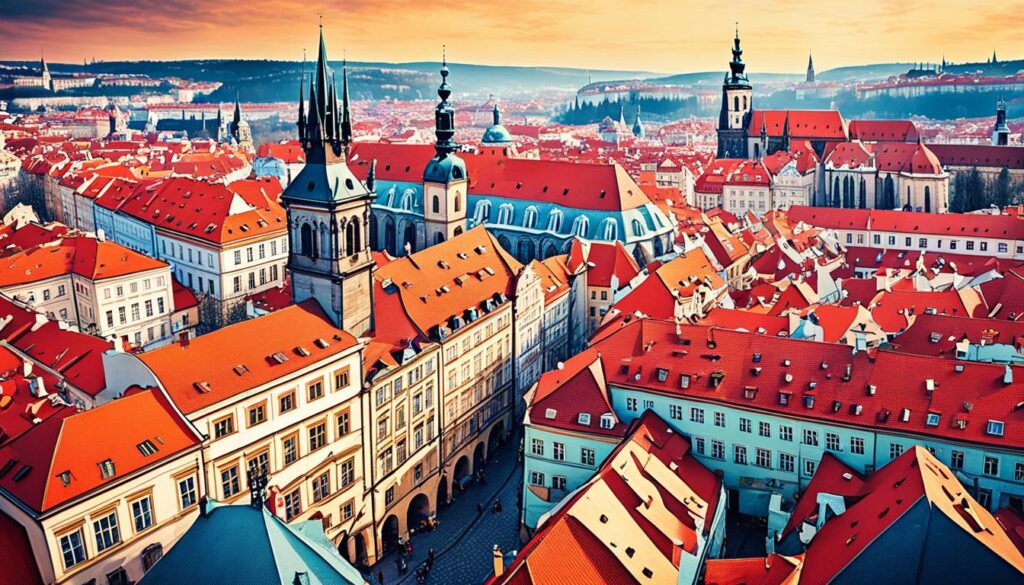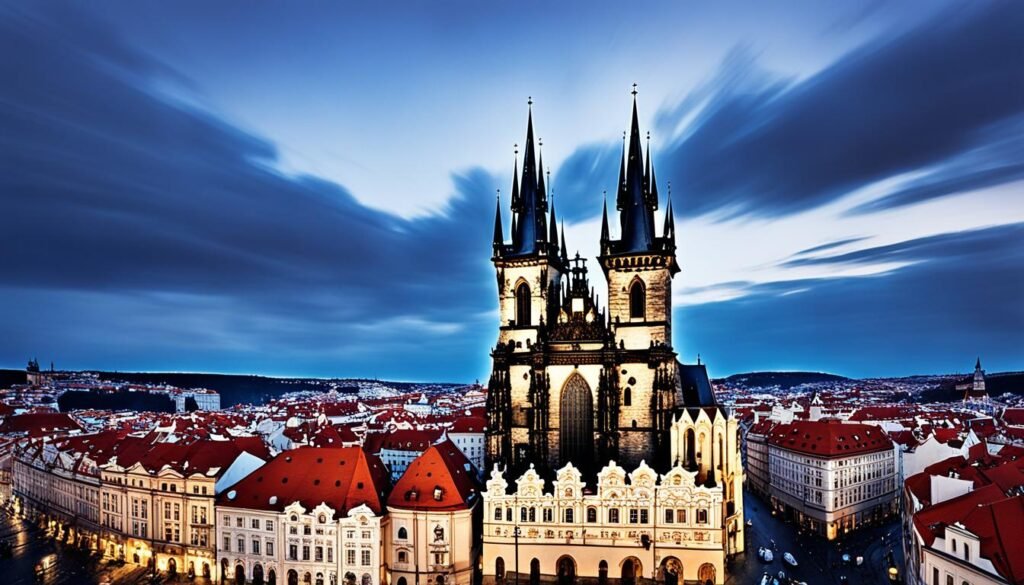From the mighty Great Moravian Empire to the illustrious Bohemian Kingdom, the lands that now comprise the Czech Republic have long been a vibrant hub of artistic and cultural expression. Over the centuries, the region’s distinct identity has been shaped by a rich tapestry of international influences, from the Italian Renaissance to the elegant aesthetics of Art Nouveau. This captivating tale of Bohemian art history is one that reverberates through the very fabric of Prague, the enchanting capital city that stands as a testament to the enduring legacy of Central European creativity.
Key Takeaways
- The Czech Republic’s historic lands of Bohemia, Moravia, and Silesia have fostered a unique cultural identity and artistic tradition.
- Bohemia’s political formations, from the Great Moravian Empire to the Bohemian Kingdom, have shaped the region’s artistic profile.
- Prague, the capital city, has emerged as a prominent cultural center, attracting international influences and fostering artistic innovation.
- Central European art in the Czech Republic has been defined by the interplay of diverse cultural exchanges, including the migration of artists, forms, and styles.
- The Czech Republic’s rich art history encompasses a wide range of movements, from the Renaissance and Baroque to Art Nouveau and Art Deco.
The Early Roots: From the Great Moravian Empire to the Bohemian Kingdom
The story of Bohemian art history begins with the rise of the Great Moravian Empire, a powerful Slavic state that flourished in the 9th century. This region, known for its rich medieval architecture and the influence of the Bohemian Kingdom, would later become the foundation for the cultural legacy of the Czech Republic.
The Artistic Beginnings of the Western Slavs
The Western Slavs, including the Czechs, Moravians, and Slovaks, began to develop their own distinct artistic traditions during the Great Moravian Empire. This period saw the construction of early Gothic cathedrals and the emergence of a vibrant artistic scene, laying the groundwork for the eventual rise of Prague as a cultural center.
The Rise of Prague as a Cultural Center
As the Bohemian Kingdom solidified its control over the region, Prague began to assert itself as a major hub of art and culture. The city’s strategic location, coupled with the patronage of the Přemyslid dynasty, allowed it to become a crossroads for trade and the exchange of ideas. This paved the way for Prague’s transformation into a cosmopolitan city, renowned for its architectural wonders and cultural achievements.

Renaissance Art in Bohemia and Moravia: Italian Influences
As the 15th century drew to a close, the artistic and cultural landscape of Bohemia and Moravia began to evolve, with the introduction of Renaissance influences. This transformation was largely facilitated by the arrival of Italian artists, stonemasons, and masons from the Ticino canton in southern Switzerland, who traveled through Austria to Bohemia and Moravia, drawn by the allure of the Corvin and Jagiellonian courts in neighboring Hungary.
The influx of these Italian Renaissance painters, Baroque sculptors, and other Italian artists ushered in a new era of cultural exchange and cross-pollination. This transcultural and international character of the visual arts in Bohemia and Moravia continued to thrive until the end of the 17th century, as the royal court and a growing group of elite aristocratic families embraced the Renaissance style.
The urban environments of Bohemian and Moravian cities and towns also provided a fertile ground for the assimilation of this new artistic language, partly due to the fact that the Italian immigrants, often referred to as “Welsche leute” in German or “Vlaši” in Czech, became integrated members of the local communities.

This dynamic period marked the first significant connection between Bohemia, Moravia, and the Renaissance culture and art that was flourishing across the Italian peninsula and beyond. The legacy of these Italian influences would continue to shape the artistic trajectories of the region for centuries to come.
The Golden Age: Prague under Charles IV and the House of Luxembourg
During the 14th century, the House of Luxembourg rose to power in Bohemia, bringing about a remarkable era of cultural and architectural flourishing. Charles IV, the Bohemian king and Holy Roman emperor, made Prague the center of his domain from 1346 to 1378, leaving an indelible mark on the city’s medieval architecture and Gothic cathedrals.
Charles University and the Blossoming of Scholarship
In 1348, Charles IV founded the Charles University, the first university in central Europe, which attracted scholars and students from across the continent. This institution became a hub of learning, contributing to the intellectual and cultural renaissance that defined the reign of the House of Luxembourg.
Architectural Marvels: The Charles Bridge and St. Vitus’ Cathedral
Charles IV also oversaw the construction of the iconic Charles Bridge, linking the Old Town and the Malá Strana, and the beginning of the majestic St. Vitus’ Cathedral, a true masterpiece of Gothic architecture that would not be completed until 1929. These architectural wonders continue to captivate visitors and serve as enduring symbols of Prague’s rich cultural heritage.
Czech Republic: Bohemian art history Prague Czech Republic
The history of Bohemian art and culture in the Czech Republic is deeply intertwined with the nation’s rich past. From 1526 until 1918, Bohemia and Moravia were part of the sprawling Habsburg monarchy, which had a profound impact on the region’s artistic and cultural development.
One significant event during this period was Emperor Rudolph II’s decision to move his seat from Vienna to Prague in 1583. This transformed the city into an international cultural center of Central Europe, much like it had been during the reign of the Luxembourg emperor, Charles IV, centuries earlier. This extraordinary shift reflects the significant influence of the Habsburg rulers and their court culture on Bohemia and Moravia.

The influx of Habsburg court culture and patronage fostered a rich artistic environment in Prague, which became a hub for Bohemian art and architecture. This era saw the rise of renowned Baroque and Classicist masterpieces, as well as the emergence of the distinctive Czech Art Nouveau style, exemplified by the works of Alphonse Mucha. The legacy of this vibrant cultural era continues to shape the Czech Republic’s artistic identity and reputation as a center of Central European art.
The Hussite Rebellion and the Late Gothic Splendor
Prague played a pivotal role in the Reformation movement. The sermons of Jan Hus, a scholar at the university, began in 1402 at the Bethlehem Chapel and carried forward the criticisms of the church developed by the English reformer John Wycliffe. Hus’s message resonated with the common people, but it also brought him into conflict with Rome. Tragically, he was burned at the stake in the town of Constance (Konstanz, Germany) in 1415.
Jan Hus and the Reformation Movement
The Hussite Rebellion soon followed, with popular uprisings in 1419 led by the Prague priest Jan Želivský. This included the infamous “Defenestration of Prague,” where city councilors were thrown from the windows of the New Town Hall. The next year, Hussite peasant rebels, led by the military leader Jan Žižka, joined forces with the Hussites of Prague to win a decisive victory over the Roman Catholic king (later emperor) Sigismund at nearby Vítkov Hill.
During the next two centuries, the late Gothic architectural style flourished in many churches and buildings, reaching a peak in the fine Vladislav Hall of Hradčany. The Hussite Rebellion and the subsequent Reformation movement had a lasting impact on the region’s Gothic cathedrals and Late Gothic architecture.

The Habsburg Era: Baroque and Classicism
As the Roman Catholic Habsburgs gained control of Bohemia in 1526, they set out to crush the growing Protestant movement in the region. This led to the second Defenestration of Prague in 1618, a pivotal event that sparked the Thirty Years’ War. The defeat of Protestant forces at the Battle of the White Mountain in 1620 solidified the Habsburgs’ grip on power.
The period that followed saw a surge of Baroque sculpture and architecture, as the Habsburg monarchy sought to reassert its Catholic identity and cultural dominance. Prague, once the capital of the empire, went into decline, occupied by Saxon and Swedish forces and ravaged by outbreaks of plague. Yet, amidst this turmoil, the city also witnessed the rise of Classicism, as a new aesthetic emerged to challenge the ornate excesses of the Baroque.
The Baroque era left an indelible mark on the art and architecture of the Czech Republic, with grand cathedrals and palaces showcasing the opulent style. Simultaneously, the influence of Classicism, with its emphasis on symmetry and proportion, began to gain traction, heralding a new era in the country’s artistic evolution.
Art Nouveau in Prague: Mucha and the Organic Aesthetic
Prague blossomed into one of the premier centers of the Art Nouveau style during the late 19th and early 20th centuries. At the forefront of this artistic renaissance was the renowned Czech painter and designer, Alphonse Mucha. Mucha’s distinctive organic aesthetic, marked by flowing, naturalistic forms and vibrant colors, left an indelible mark on the city’s architectural and decorative landscape.
The Municipal House and the Triumph of Art Nouveau Design
Mucha’s mastery of the Art Nouveau style was perhaps best exemplified in his work on the Municipal House, a Prague landmark that stands as a testament to the city’s cultural and artistic heritage. Commissioned to decorate the circular salon of the Lord Mayor’s Hall, Mucha created a breathtaking decorative scheme that celebrated the heroic past of the Czech people and the unity of the Slav nations. Replete with Mucha’s original furnishings and curtains, the room is a stunning showcase of the Art Nouveau movement’s organic aesthetic.
Mucha’s Stained Glass and Decorative Works
Mucha’s influence on Prague’s Art Nouveau landscape extended beyond the Municipal House. In 1931, he was commissioned to design a stained-glass window commemorating the Millennium Jubilee of the Czech patron saint, St. Wenceslas. This magnificent work, installed in the north nave of St. Vitus Cathedral, further solidified Mucha’s status as one of the leading practitioners of the Art Nouveau style in Prague.
The Transition to Art Deco: František Roith and the Mayor’s Residence
As Prague’s architectural landscape evolved, the city witnessed a remarkable transition from Art Nouveau to the burgeoning Art Deco style. At the forefront of this transformation was architect František Roith, whose visionary designs left an indelible mark on the city’s skyline. One of Roith’s most celebrated works is the stunning Mayor’s Residence, begun in 1925, which seamlessly blended Czech Art Nouveau influences with the sleek, geometric lines of Art Deco.
The Mayor’s Residence stands as a testament to Roith’s mastery of design, showcasing a harmonious fusion of these two distinct aesthetic movements. The building’s elegant façade, adorned with ornate Art Nouveau-inspired flourishes, belies the pure Art Deco elegance that permeates its interior. From the original light fixtures to the meticulously crafted soft furnishings, every element of the Mayor’s Residence was designed to embody the refined and progressive spirit of the Art Deco style.
Remarkably, many of these original design features were preserved through the turbulent decades of the communist occupation, only to be lovingly reinstalled following the Velvet Revolution in 1989. Today, the Mayor’s Residence stands as a testament to the enduring legacy of Art Deco in Prague, a testament to the vision of František Roith and the city’s unwavering commitment to preserving its architectural heritage.
Conclusion
The rich and diverse art history of the Czech Republic, encompassing the regions of Bohemia, Moravia, and Silesia, has been a testament to the country’s cultural significance within Central Europe. From the artistic beginnings of the Western Slavs in the Great Moravian Empire to the flourishing of various artistic movements, including Renaissance, Baroque, Gothic, Art Nouveau, and Art Deco, the Czech lands have been a hub of creative expression and innovation.
The lasting impact of these stylistic influences can be seen in the country’s architecture, painting, sculpture, and decorative arts, making the Czech Republic a true center of Bohemian art history. The country’s art has been shaped by its unique political, cultural, and social dynamics, reflecting the diverse cultural heritage that has come to define the nation.
As a result, the Czech Republic stands as a testament to the enduring legacy of Bohemian art, a legacy that continues to captivate and inspire audiences from around the world. From the iconic Charles Bridge and St. Vitus’ Cathedral to the stunning works of Alfons Mucha, the art of the Czech Republic remains a vital and integral part of the country’s cultural identity and heritage.
Source Links
- Prague – Bohemian, Czech, Capital – https://www.britannica.com/place/Prague/History
- Renaissance and Rudolphine Art of Bohemia and Moravia – https://www.oxfordbibliographies.com/abstract/document/obo-9780199920105/obo-9780199920105-0085.xml
- Czeching out Prague’s Art Nouveau Masterpieces | The Decorative Arts Trust – https://decorativeartstrust.org/czeching-out-pragues-art-nouveau-masterpieces/


